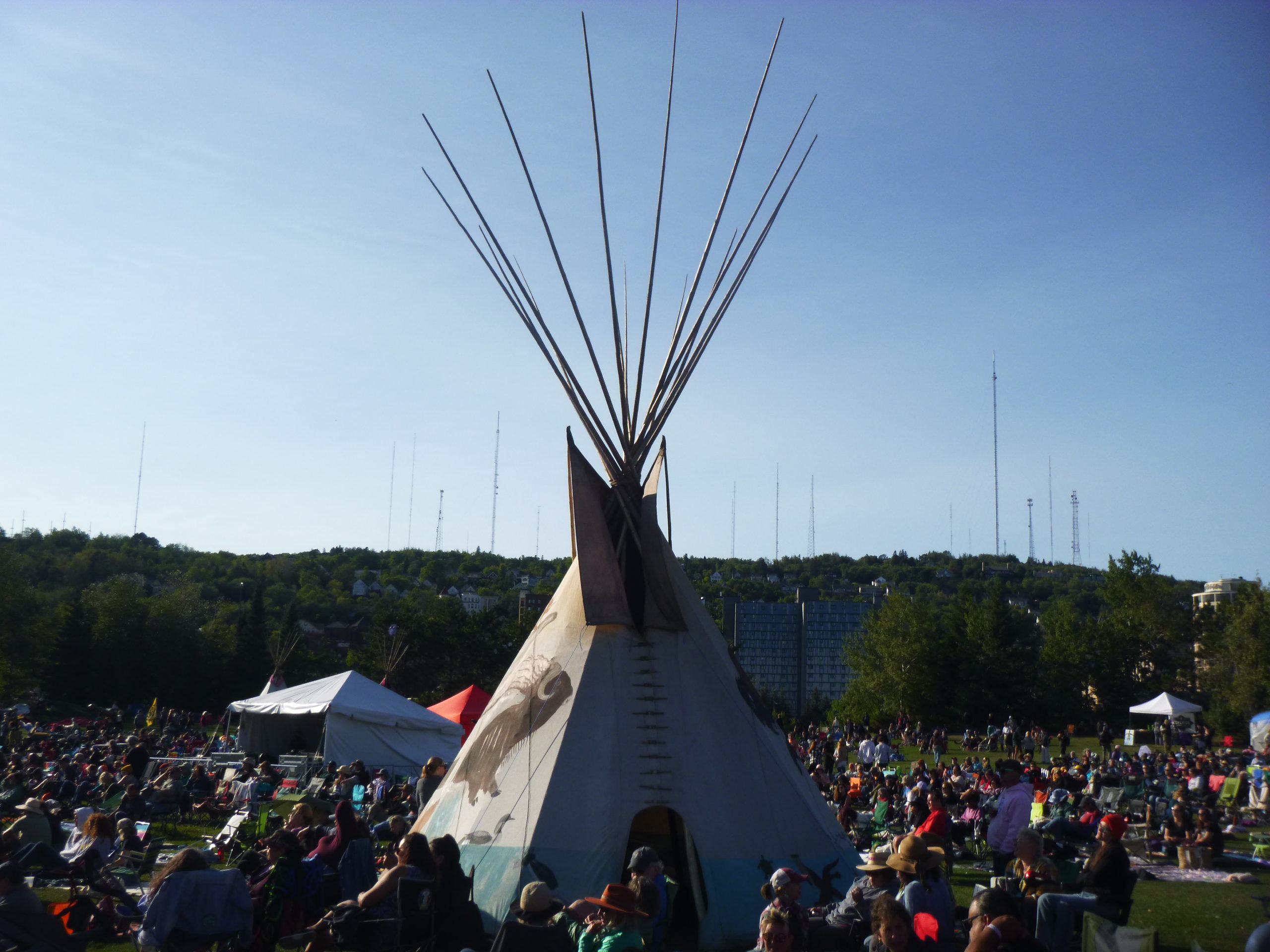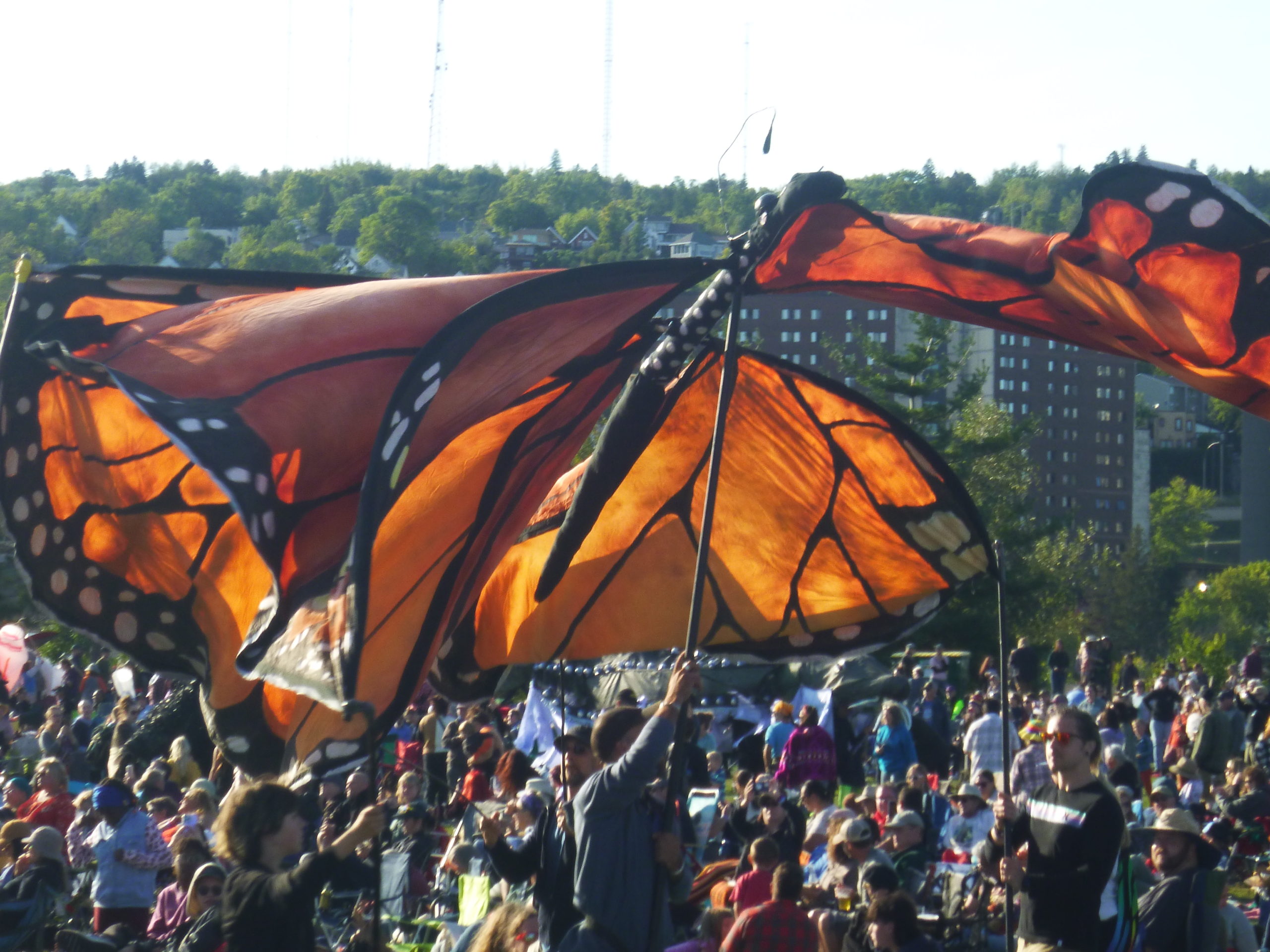
Editor’s Note: “Nibi Chronicles,” a monthly Great Lakes Now feature, is authored by Staci Lola Drouillard. A direct descendant of the Grand Portage Band of Ojibwe, she lives and works in Grand Marais on Minnesota’s North Shore of Lake Superior. Her two books “Walking the Old Road: A People’s History of Chippewa City and the Grand Marais Anishinaabe” and “Seven Aunts” were published 2019 and 2022, and she is at work on a children’s story. “Nibi” means water in Ojibwe, and these features will explore the intersection of indigenous history and culture in the modern-day Great Lakes region.
Keith Secola called out the clan animals.
The famous Anishinaabe songwriter from Minnesota’s Iron Range, Keith was on stage with his “wild band,” including a jingle dress dancer, a hoop dancer, and the actor (and pretty impressive harmonica player) Gary Farmer. Some of you might know him as Uncle Brownie on Reservation Dogs, or Philbert from Pow Wow Highway.
This was the second-annual Water is Life music, art and culture festival at Bayfront Park in Duluth, Minnesota earlier this year.
It was a typical early fall day — warm over the hill but chilly by the Lake. The outdoor stage at Bayfront is positioned so that everyone in the audience faces the water. Just west is Onigamiinsing—the ancient portage across Minnesota Point, roughly located where the ship canal is today.

The Water is Life music, art and culture festival was held at Bayfront Park in Duluth, Minnesota. (Photo Credit: Staci Lola Drouillard)
The music lineup was stellar—Annie Humphrey, David Huckfelt, Thomas X, Low, Dessa, Ani DiFranco, and the Indigo Girls to name a few. I saw friends from Grand Portage and even some people I knew from Minneapolis, back in the day.
There were tipis set up all around the park, a signal that this is Native territory. Duluth’s industrialism was also on display, with enormous lakers occasionally obscuring the horizon: ships designed to move taconite pellets and other cargo across Lake Superior, making their way toward Thunder Bay, or across to Sault Ste. Marie.
While Keith sang about our Anishinaabe homelands, a thunderbird emerged from the north, followed by maa’ingan the wolf, makwa the bear, maymengwaa the monarch butterfly and namay the sturgeon. Dancing to the rhythm of the drum, these woodland denizens of Ojibwe country were there to remind everyone that it’s not just humans who drink water.

These woodland denizens of Ojibwe country were there to remind everyone that it’s not just humans who drink water. (Photo Credit: Staci Lola Drouillard)
Ojibwe people grew up on stories about the mountainous places where the thunderbird lives. A great protector of all, this mystical bird is capable of raining down lightning on enemies of the people. The timber wolf, a fierce protector of family and kin, snarled and rocked to the beat. Her presence, a furry reminder that we are all related.
The great black bear, denizen of the forest and our doodaim brother and sister, serves as a spiritual guide with big feet. He danced in front of the stage with bear clan families of all ages—a reverential mosh pit.
The monarch butterfly, a traveler between worlds, graced the arena with the beauty of small things.
Last in the parade was the great sturgeon. A relic from another age, sturgeon were nearly decimated from the Great Lakes by the early 1900’s. If you are of the sturgeon or fish clan, your work here on earth is one of teaching others about history, and telling the living story of the people—bimaadizi adizookaan.

Last in the parade was the great sturgeon. (Photo Credit: Staci Lola Drouillard)
It was my first time at the event, and being there to experience thousands of people coming together to celebrate nibi—water, the basis of all life, gave me hope. As someone who has been standing up for the rights of clean water here on the North Shore of Lake Superior for many years, knowing that so many others feel the same way, was a reaffirmation of what’s really important.
“We’ve got a hoop extravaganza up here,” announced Keith. While the ornamental hoops circled in the air, the clan animals circled around the people, and everything was in its place at Onigamiinsing — “the little portage” — also known as Duluth.
Catch more news at Great Lakes Now:
Minnesota Ojibwe harvest sacred, climate-imperiled wild rice
Living water: Northern Indigenous communities’ use and perceptions of drinking water
Photo Credit: There were tipis set up all around the park, a signal that this is Native territory. (Photo Credit: Staci Lola Drouillard)




